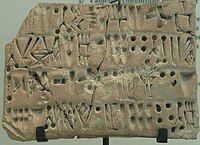Elamite language
| Elamite | |
|---|---|

Tablet of Elamite script
|
|
| Native to | Elamite Empire |
| Region | Middle East |
| Era | ca. 2800–300 BC |
|
Early forms
|
language of Proto-Elamite?
|
| Language codes | |
| ISO 639-2 | |
| ISO 639-3 | |
|
Linguist list
|
elx |
| Glottolog | elam1244 |
Elamite is an extinct language spoken by the ancient Elamites. Elamite was a language used in present-day south-western Iran from 2800 to 550 BC. The last written records in Elamite appear about the time of the conquest of the Achaemenid Empire by Alexander the Great. Elamite has no demonstrable relatives and is usually considered a language isolate. The lack of established relatives is one reason that interpretation of the language is difficult.
Elamite cuneiform, adapted from Akkadian cuneiform, was used from ca. 2500 to 331 BC. Elamite cuneiform was largely a syllabary of some 130 glyphs at any one time and retained only a few logograms from Akkadian, but over time, the number of logograms increased.
The complete corpus of Elamite cuneiform consists of c. 20 thousand tablets and fragments. The majority belong to the Achaemenid era, and contain primarily economic records.
Two earlier scripts of the area remain undeciphered but plausibly have encoded Elamite:
Elamite was an agglutinative language, and Elamite grammar was characterized by a well-developed and pervasive nominal class system. Animate nouns had separate markers for 1st, 2nd, and 3rd person, a rather unusual feature. It can be said to display a kind of Suffixaufnahme in that the nominal class markers of the head were also attached to any modifiers, including adjectives, noun adjuncts, possessor nouns, and even entire clauses.
The history of Elamite is periodised as follows:
Middle Elamite is considered the “classical” period of Elamite, but the best attested variety is Achaemenid Elamite, which was widely used by the Achaemenid Persian state for official inscriptions as well as administrative records and displays significant Old Persian influence. Documents from the Old Elamite and early Neo-Elamite stages are rather scarce.
...
Wikipedia
